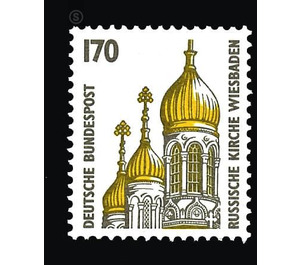Postage stamps: sights - Germany / Federal Republic of Germany 1991 - 170 Pfennig
Theme: Architecture
| Country | Germany / Federal Republic of Germany |
| Issue Date | 1991 |
| Face Value | 170.00 |
| Color | yellow white |
| Perforation | K 14 |
| Printing Type | 2-color high pressure |
| Stamp Type | Postage stamp |
| Item Type | Stamp |
| Chronological Issue Number | 1408 |
| Chronological Chapter | GER-BRD |
| SID | 895305 |
| In 49 Wishlists | |
Situated in a prominent location on the Neroberg, the "home mountain" of Wiesbaden, the Russian Church is a symbol of the city. It was built in the years 1847-1855 on a specially designed platform on the eastern slope of the mountain as a funerary church for the first wife of Duke Adolf of Nassau, the Russian Grand Duchess Elisabeth Mikhailovna. The major part of the construction costs of more than 450,000 guilders was disputed from the interest on the marriage dowry deposited with the Russian bank in Petersburg. Elisabeth Michailovna, born on 26 May 1826 in St. Petersburg, daughter of Grand Duke Michael and niece of Tsar Alexander I and Nicholas I, married on January 31, 1844 Duke Adolf of Nassau (1817-1905), later Grand Duke of Luxembourg (since 1890). One year later, on January 28, 1845, she died in Schloß Biebrich in the puerperium - the child, a daughter, had died shortly after birth the day before. The Duke's decision to build a funerary church was determined by his deceased wife's belonging to the Russian Orthodox faith. It was to rest on a site dedicated to Orthodox rite. The construction contract was awarded to architect Philipp Hoffmann, who had made extensive study trips to the Russian church art and had in his designs influenced by the style of the Russian church architect Konstantin Andrejewitsch Thon, who incidentally also designed the Kremlin. In a mixture of Byzantine and ancient architectural elements, a main dome flanked by four pointed domes rises up to a height of 55 meters on the basis of a Greek cross. The design of bright sandstone in rich ornamentation and the gilding of the domes contrast effectively with the dark colors of the surrounding forest. The iconostasis (altar walls with sacred representations) of the precious interior was created by the court painter of St. Petersburg, the sarcophagus made of carrara marble with the life-size painting of the dead was designed by the sculptor Emil Hopfgarten. On May 25, 1855 the sepulchral church was inaugurated after the Russian Orthodox rite. Already the following night, the coffins of the deceased Duchess and her child, which had previously been installed in the Mauritius and then in the Boniface Church. Since the Orthodox faith in the linguistic usage of that time was called "Greek faith," the misleading term "Greek chapel" was used for the building. The church serves as a church of the Russian Orthodox community in Wiesbaden, in whose property it is also located. In its immediate vicinity lies the Russian cemetery with the graves of numerous personalities, among them the painter Alexey von Jawlensky (1864-1941). The church is a special tourist attraction, whose appeal is enhanced by the panoramic view of Wiesbaden from Neroberg. (Text: city archive Wiesbaden)


